10 Tips for Creating a Productive Home Office Space
Finding the perfect spot for your home office is key. You might have an extra room, a part of your bedroom, or a cozy space elsewhere. The right location is your first step to a productive work spot at home.
Why is the home office location so important?
A good home office spot offers privacy and reduces distractions. It’s vital to have a workspace that encourages a solid work-life balance. This helps you mentally prepare to work once you enter your office space.
Create a Separate Workspace for Optimum Focus
Setting up a distinct workspace at home helps separate work from personal life. Stepping into your office signals your brain to stay focused. This physical divide helps reduce interruptions and boosts your efficiency.
“Having a separate workspace allows you to maintain a healthy work-life balance by creating clear boundaries between your professional and personal life.”
A distinct workspace cuts down on distractions from home or family. It helps you focus more on work. This increases your productivity.
What should you consider when choosing a home office location?
Think about natural light, noise, and privacy when picking a spot. Look for a quiet area without disruptions. Ideally, place your desk near a window for natural sunlight. This boosts your mood and energy.
Also, find a spot that offers the privacy you need to concentrate. This could be a spare room with a door or a specific corner you can make your own.
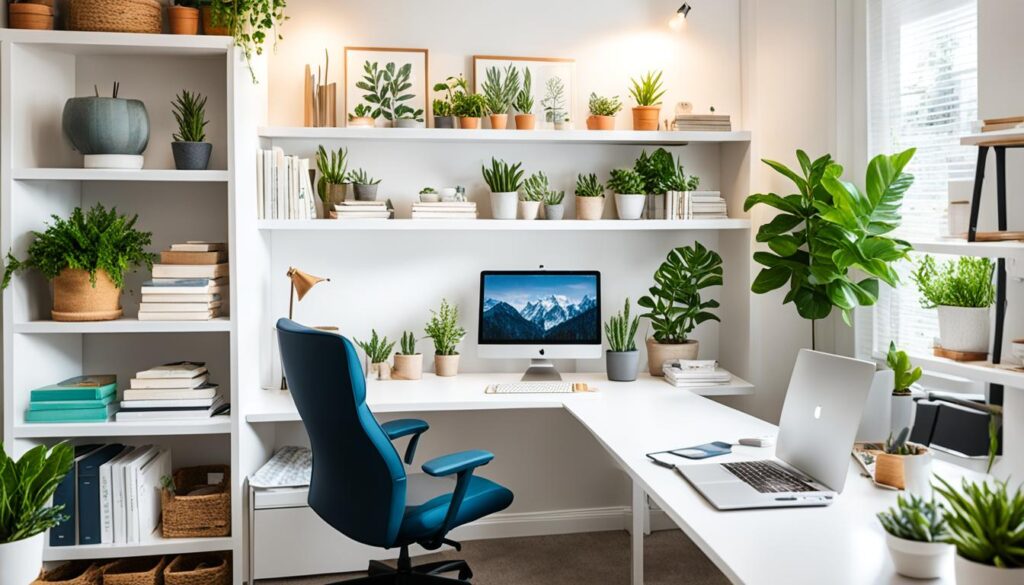
Starting with the right location is crucial for a productive home office. With a focused workspace that promotes work-life balance, you’ll achieve great productivity at home.
Prioritize Functionality and Productivity in Your Home Office Setup
Setting up your home office requires focus on functionality and productivity. Key factors like temperature, lighting, and clutter play a major role. They help create an efficient space with fewer distractions.
- Temperature: Make sure your office has a comfortable temperature to work in. Whether it is cool or warm, the right temperature boosts productivity.
- Lighting: Good lighting is crucial for your health and focus. Place your desk by a window to use natural light. Also, task lighting can brighten specific work areas.
- Clutter: A tidy workspace helps you concentrate better. Clean your desk of things you don’t need. Shelves, filing cabinets, and organizers can keep your essentials tidy.
“A functional home office is the foundation for a productive work environment. By carefully considering factors such as temperature, lighting, and clutter, you can create a space that supports your productivity goals.” – Jane Johnson
Another important part is adding productivity tools and digital planners to your routine. These tools streamline your work process. They help manage your tasks and keep you on track with your goals.
Use project management tools like Trello or Asana for task organization and team collaboration. Productivity apps like Evernote or Todoist are great for noting ideas, making lists, and setting reminders.
A well-set home office is key to staying focused and motivated. Focus on its functionality, arrange your space well, and use productivity tools. This way, you create an environment that helps you do your best work.
Key Takeaways:
- Prioritize temperature, lighting, and clutter management in your home office setup to enhance functionality and productivity.
- Position your desk near a window to maximize natural light and use task lighting for focused illumination.
- Keep your workspace organized and free from unnecessary clutter to minimize distractions.
- Integrate productivity tools and digital planners to streamline your work processes and stay organized.
Invest in Ergonomic Furniture for Your Home Office
A comfy and effective home office is more than just a good spot and a well-organized space. It’s also key to choose ergonomic furniture. This type supports your health and makes work better.
When picking a chair, comfort and lower back support are top priorities. Look for one that lets you adjust the height, armrests, and back tilt. This way, it suits your liking. Chairs with padded seating are great for comfort when you’re sitting for hours. Without the right support, you might suffer from back pain and bad posture. This can affect your health and how well you work.
Don’t forget about your desk. It should have enough room for all your work stuff. Desks that you can adjust in height or ones with adjustable trays for keyboards are best. They help keep your posture right, reducing stress on wrists and shoulders.
Think about getting a standing desk or a desk that adjusts. This lets you stand or sit as you work through the day. It helps avoid sitting too long. Standing desks also promote better blood flow.
Ergonomic furniture not only makes you comfortable but also boosts your health and work output. With the right chair and desk, you can lessen discomfort. This helps you keep your mind on your work.
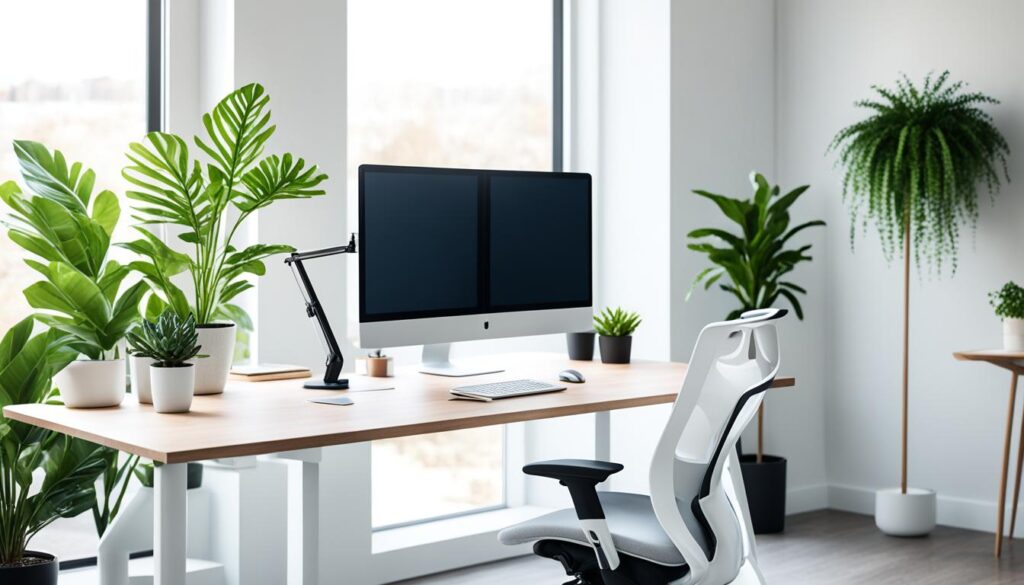
Benefits of Ergonomic Furniture
Ergonomic furniture provides numerous benefits that positively impact your overall work experience. Here are some key advantages:
- Promotes good posture and reduces the risk of musculoskeletal issues
- Minimizes discomfort and fatigue during long work hours
- Enhances productivity and focus by eliminating distractions caused by discomfort
- Improves circulation and prevents health issues associated with prolonged sitting
- Increases energy levels and reduces the likelihood of midday slumps
- Contributes to a professional and organized home office environment
Choosing ergonomic furniture is a way to care for your health while working from home. It makes sure you’re comfortable. This sets you up for better work and greater job happiness.
Create a Well-Lit Home Office Environment
Good lighting is key in a home office. It boosts your mood and energy. It also lowers the chance of eyestrain. Having enough light is vital for feeling good and doing well in work.
Try to put your desk by a window to get more sunlight. Sunlight makes you feel less tired and more sharp. It even helps you do better at work and feel happier. Letting in lots of sunlight connects you with the outdoors.
“Natural light is the best light for productivity and well-being. It not only saves energy but also promotes a positive working environment.” – Dr. Jane Thompson, Lighting Expert
If you can’t get enough natural light, use desk lamps or ceiling lights. Make sure they’re bright enough and don’t reflect on your screen. This helps avoid eyestrain. LED lights are good because they’re bright and save energy.
The right office lighting is about quality, not just how much light there is. You might need different lights for different work. Adjustable lamps can change in brightness and color. This helps you get the right light all day.
A well-lit workspace is great for work and health. It makes your office look professional and welcoming. Focus on getting sunlight and the right lamps. This reduces eyestrain and helps you feel your best.
| Benefits of Well-Lit Home Office |
|---|
| Improved mood and energy levels |
| Reduced eyestrain and fatigue |
| Increased productivity and focus |
| Enhanced work atmosphere |
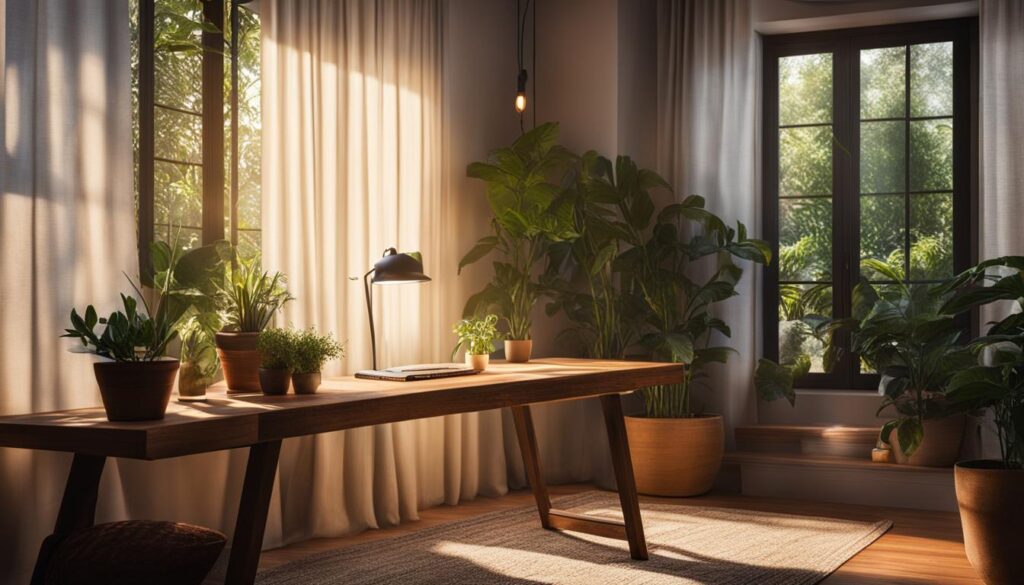
Enhance Your Tech Setup for Improved Efficiency
Upgrading your tech setup can make your home office more productive. The right tools and accessories help streamline your workflow. This optimizes your work environment.
Consider an External Monitor for Better Visibility
Adding an external monitor boosts your productivity. It offers a wider screen and better visibility. This setup lets you multitask and view multiple windows at once.
A big screen means you can compare documents or have video conferences without feeling cramped. Pick a monitor size that fits your work and desk space.
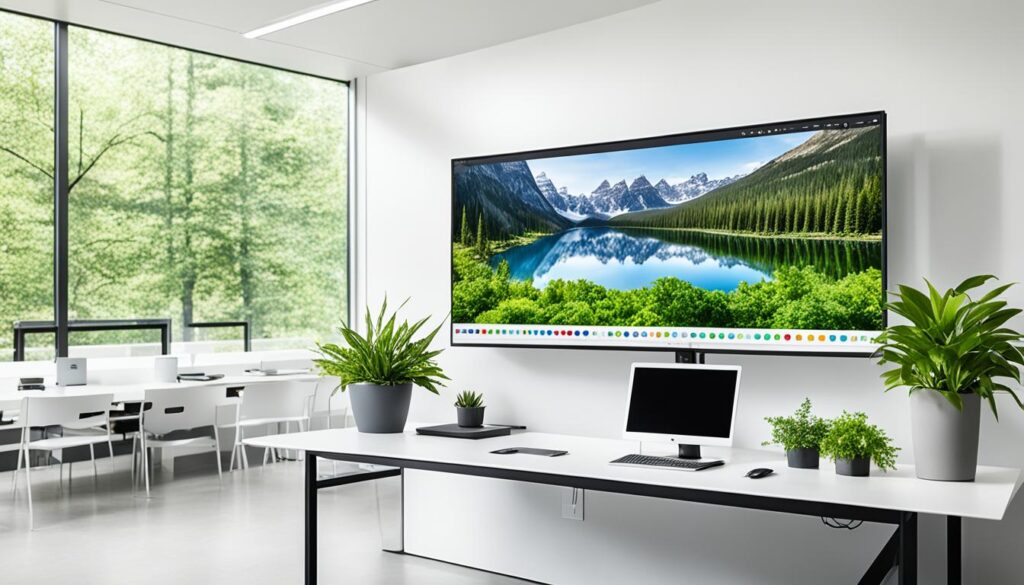
Ensure a Reliable Internet Connection
A steady internet connection is key for smooth remote work. It keeps communication going and makes file sharing and team work easy. Go for a high-speed internet plan for a stable connection all day.
Consider a wired connection for better speed and reliability. This is important if your Wi-Fi is slow or unstable. A Wi-Fi extender can also boost your signal if your office is far from your router.
Optimize Peripherals for Ergonomic Comfort
Think about the ergonomics of your peripherals in your home office. Choose a keyboard and mouse that feel natural to use. This can reduce the risk of strain injuries.
Look at ergonomic keyboards and mice that fit your hand’s shape. These adjustments can lessen discomfort and make work more pleasant.
Secure Your Files with Backup Solutions
It’s crucial to protect your work files and data as a remote worker. Use cloud storage for backups to keep your documents safe. Services like Google Drive, Dropbox, or Microsoft OneDrive are secure for file storage and syncing.
These services have automatic backup, so you don’t lose work due to a computer problem or a mistake.
| Benefits of Enhancing Your Tech Setup | Examples |
|---|---|
| Improved productivity | A larger screen enables efficient multitasking. |
| Seamless remote collaboration | A reliable internet connection facilitates smooth communication and file sharing. |
| Ergonomic comfort | Using an ergonomic keyboard and mouse reduces the risk of strain injuries. |
| Data protection | Backup solutions like cloud storage ensure the safety of your important files. |
Enhancing your tech setup leads to a better home office. A bigger monitor, stable internet, comfy peripherals, and backup solutions equip you for remote work.
Optimize Sound Management in Your Home Office
Working from home means needing a quiet space. Making your office noise-free boosts your focus and work output. Here are tips to manage sound well in your home office.
Choose a Quiet Location
Look for a silent spot in your house for your office. It could be an unused room or a quiet corner. Picking a peaceful place helps make your work area calm.
Communicate Your Need for a Quiet Environment
Tell your family or housemates about your work schedule. Explain why quiet times are important. This conversation will set boundaries and help everyone understand, making things better for all.
Consider Noise-Canceling Headphones
Noise-canceling headphones are a smart choice. They cut down background noise. This lets you concentrate better on your work.

Use Video Conferencing Software with Noise Suppression
In online meetings, choose software that can suppress noise. This feature keeps your voice clear by blocking out extra sounds. It helps avoid distractions from external noises.
Create a Conducive Work Environment
Creating a quiet office means cutting distractions. Keep your desk tidy and free from mess. A clean and tranquil setting improves focus and work quality.
Sound management makes a big difference in home offices. Choosing a quiet area, using special headphones, and communicating well helps make your work space better. These steps lead to better productivity and a peaceful office.
Implement Organizational Systems for a Clutter-Free Home Office
Creating an organized and clutter-free home office boosts productivity and focus. Effective organizational systems reduce distractions and streamline your workflow. Here are tips, storage solutions, and digital strategies for an efficient workspace:
1. Utilize Filing Cabinets, Shelves, and Storage Containers
Keep supplies and documents organized with filing cabinets, shelves, or containers. Assign categories to each, like stationery or paperwork. This ensures an organized approach.
2. Sort and Organize Digital Files and Folders
Digital clutter can distract as much as physical clutter. Sort your digital files and folders in a logical way. Use folders and subfolders with consistent labels for easy access.
3. Set Aside Time for Quick Cleanups
Keeping a tidy workspace requires regular effort. Dedicate a few minutes daily to declutter. Clear your desk, put away supplies, and organize cables for a neat workspace.
4. Implement a Document Management System
An efficient document management system is key for a clutter-free office. Use cloud storage to easily store, organize, and access files. This keeps your digital workspace orderly.
5. Label Everything
Labeling helps keep your office organized. Mark shelves, containers, and folders to know their contents. This saves time and prevents misplacing items.
6. Create Zones for Different Activities
Have specific areas for various activities in your home office. A space for computer work, another for creativity, and a section for materials helps focus and organization.
7. Minimize Paper Clutter
Go digital to reduce paper clutter. Use digital documents, receipts, and invoices. Scan and store important papers electronically to save space.
8. Establish a Daily Routine
Include decluttering in your daily routine. Spend 10 minutes each morning to tidy up or organize digital files at day’s end. Being consistent keeps your office organized.
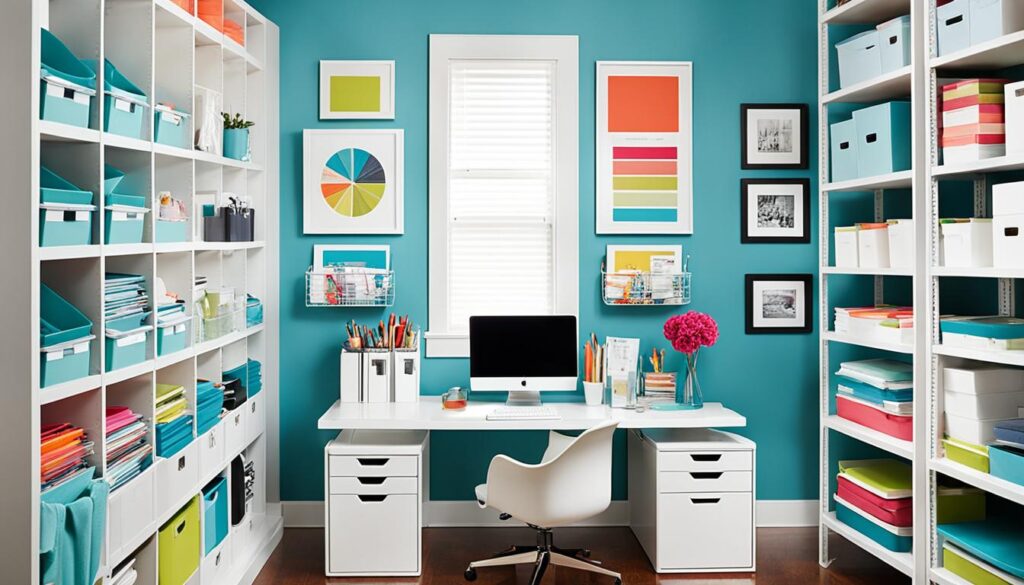
With these tips and strategies, you can have a clutter-free home office. Establish and maintain systems for a productive and focused workspace.
Pay Attention to Privacy and Security in Your Home Office
Setting up a home office requires attention to privacy and security. It’s important to protect sensitive info and ensure a safe workspace. By using the right practices and secure storage, you keep your data safe from unauthorized access.
Review Your Company’s Remote Work Policy
Start by reviewing your company’s remote work policy. It’s key to understand security guidelines and confidentiality needs. Make sure to comply and follow recommended practices to protect company info.
Use Password-Protected Devices and Enable Two-Factor Authentication
Password-protect your devices as an initial security step. Use strong, different passwords for all work devices. Add two-factor authentication (2FA) for more security. With 2FA, a second step like a text code or fingerprint is needed to access accounts, making unauthorized access harder.
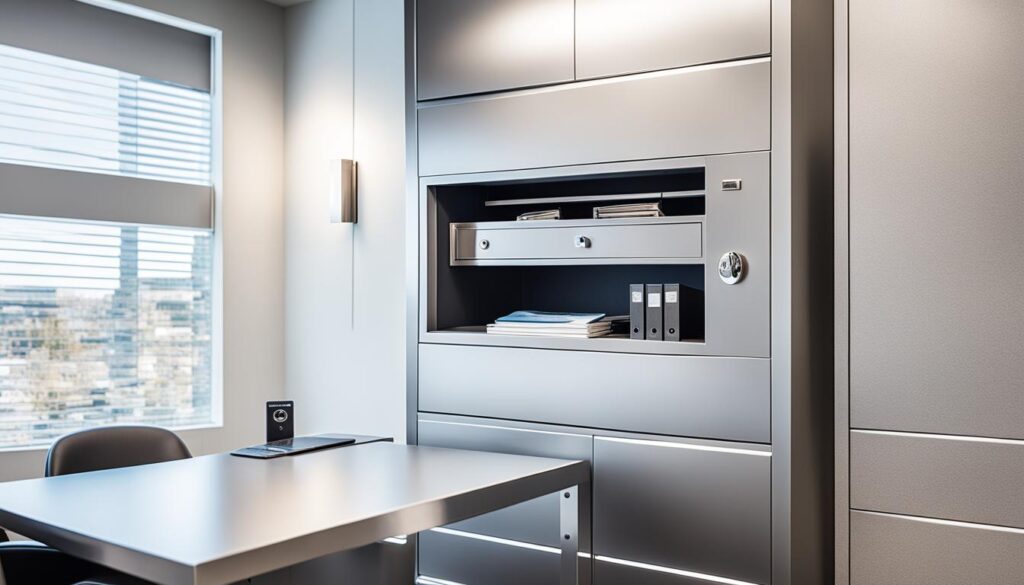
Invest in Secure Storage Solutions
It’s vital to protect physical documents at home. Use locking cabinets or safes for safe storage. This prevents access by the wrong people and reduces breach risks.
Utilize a Virtual Private Network (VPN)
Using a VPN is critical when on unsecured Wi-Fi, like public hotspots. A VPN encrypts your internet connection for safety. It keeps your data and communication secure from eavesdroppers.
| Key Security Measures for Your Home Office | Description |
|---|---|
| Review remote work policy | Familiarize yourself with your company’s guidelines on remote work and security. |
| Use password-protected devices and enable 2FA | Set strong passwords and enable two-factor authentication for added security. |
| Invest in secure storage solutions | Secure sensitive documents and materials in locking filing cabinets or safes. |
| Utilize a virtual private network (VPN) | Protect your online activities and communication by using a VPN when connecting to unsecured networks. |
By adopting these practices and the right security tools, you can have a safe home office. Prioritizing privacy and security protects not just your info, but also maintains trust with your clients and employers.
Personalize Your Home Office Space for Inspiration
Making your home office reflect your style adds elegance. It also helps balance work and life. Add **personal touches** like your favorite art, plants, or family photos. These details make your workspace welcoming and pleasant.
But, it’s key to balance personal tastes with productivity. Avoid too many decorations as they may distract you. **Decorating your home office** should help you focus, not the opposite. Use a whiteboard or a corner for your goals. This helps you keep track of your success.
Personalizing your home office lets it match your unique style and work method. Aim for a mix of function and beauty that suits you. A well-decorated office boosts the work atmosphere, your work-life balance, and productivity.